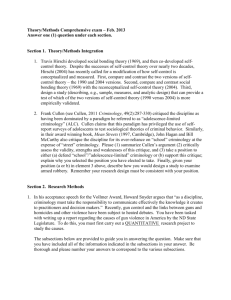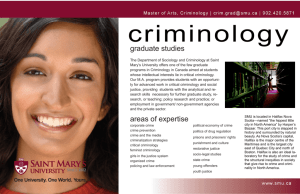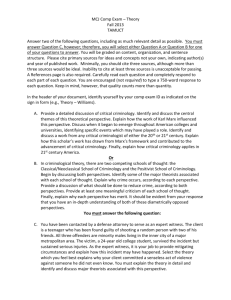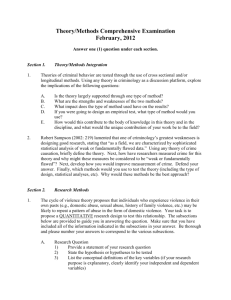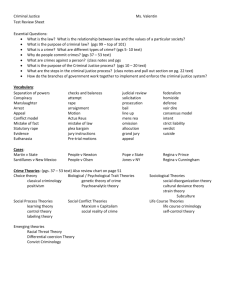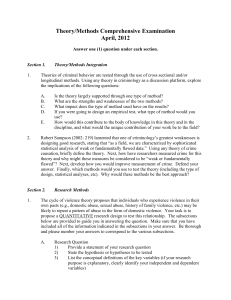August 2013 COURSE SYLLABUS Syllabus for: CRMJ/SOCI 2400
advertisement
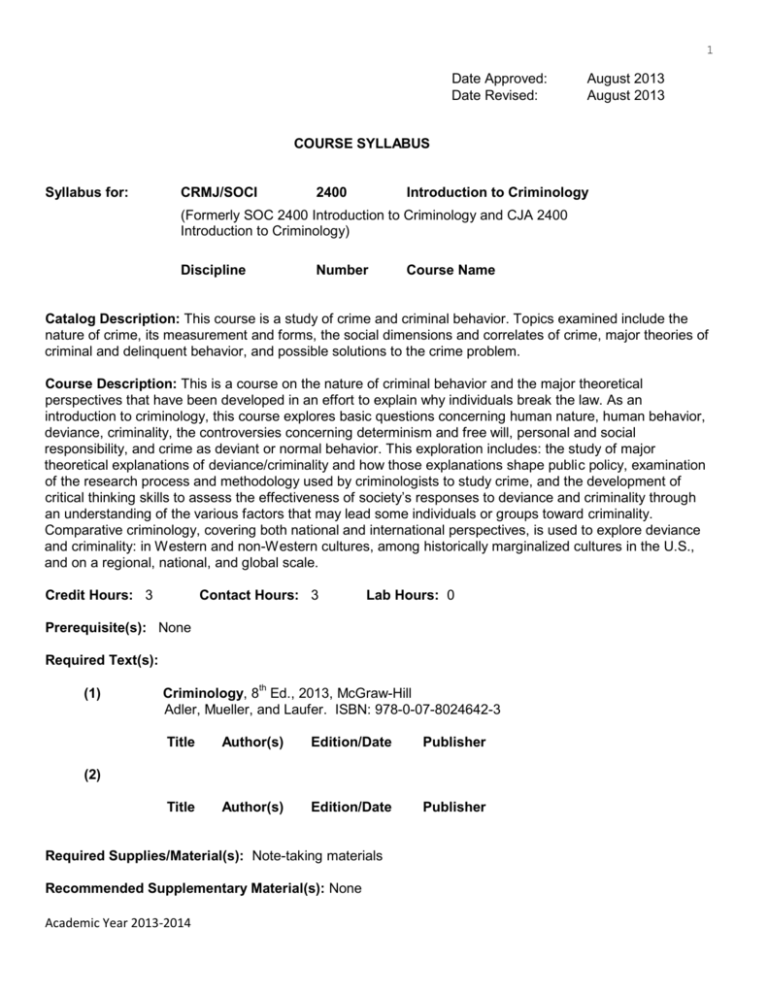
1 Date Approved: Date Revised: August 2013 August 2013 COURSE SYLLABUS Syllabus for: CRMJ/SOCI 2400 Introduction to Criminology (Formerly SOC 2400 Introduction to Criminology and CJA 2400 Introduction to Criminology) Discipline Number Course Name Catalog Description: This course is a study of crime and criminal behavior. Topics examined include the nature of crime, its measurement and forms, the social dimensions and correlates of crime, major theories of criminal and delinquent behavior, and possible solutions to the crime problem. Course Description: This is a course on the nature of criminal behavior and the major theoretical perspectives that have been developed in an effort to explain why individuals break the law. As an introduction to criminology, this course explores basic questions concerning human nature, human behavior, deviance, criminality, the controversies concerning determinism and free will, personal and social responsibility, and crime as deviant or normal behavior. This exploration includes: the study of major theoretical explanations of deviance/criminality and how those explanations shape public policy, examination of the research process and methodology used by criminologists to study crime, and the development of critical thinking skills to assess the effectiveness of society’s responses to deviance and criminality through an understanding of the various factors that may lead some individuals or groups toward criminality. Comparative criminology, covering both national and international perspectives, is used to explore deviance and criminality: in Western and non-Western cultures, among historically marginalized cultures in the U.S., and on a regional, national, and global scale. Credit Hours: 3 Contact Hours: 3 Lab Hours: 0 Prerequisite(s): None Required Text(s): (1) th Criminology, 8 Ed., 2013, McGraw-Hill Adler, Mueller, and Laufer. ISBN: 978-0-07-8024642-3 Title Author(s) Edition/Date Publisher Title Author(s) Edition/Date Publisher (2) Required Supplies/Material(s): Note-taking materials Recommended Supplementary Material(s): None Academic Year 2013-2014 2 Student Group for Whom Course is Required/Intended: Students following the Criminal Justice Associate of Arts (A.A.) or Associates of Science (A.S.) Tennessee Transfer Pathway (TTP); students following the Pre-Law area of emphasis; students aspiring to careers in law enforcement, the judicial system, and/or the correctional system; and for those interested in the subject of criminal justice. GOALS GOALS: These should be broadly stated, measurable learner outcomes expected with the completion of the course; use additional sheet(s) if necessary. 1. 2. 3. 4. Students will gain a foundational understanding of the major theories used in the field of criminology. Students will think critically about crime and criminality and evaluate competing theoretical perspectives. Students will undergo a consideration of criminality and its nature and extent. Students will evaluate and analyze societal reactions to deviance and criminality at the regional, national, and international level. 5. Students will gain insight into crime prevention through the study of crime causation. 6. Students will gain insight into the global nature of deviance and criminality through the study of comparative criminology. OBJECTIVES: These should be specifically stated, measurable learner outcomes to be met throughout the course; use additional sheet(s) if necessary. 1. 2. 3. 4. 5. Explain what is meant by the term “criminology” and describe what a criminologist does. Describe the similarities and differences between deviance and criminality. Differentiate between the consensus and conflict models of lawmaking. Explain how criminological research findings affect public policymaking. Outline the seven basic elements of crime, and the various excuses and justifications that may be used as defenses. 6. Define the following: crime, tort, felony, misdemeanor, violation. 7. Define the various methods used in data collection in criminological research. 8. Discuss the various types of crime statistics and their strengths and limitations. 9. Discuss the various characteristics by which criminals are classified. 10. Define the term “classical criminology.” 11. Specifically outline the theories of Beccaria and Bentham. 12. Define the term “positivist criminology.” 13. Define the term “biological determinism.” 14. Outline the theories of the members of the “Italian School”: Lombroso, Garofalo, and Ferri. 15. Describe how Durkheim’s anomie theory has contributed to the study of criminology. 16. Explain how Freud’s psychoanalytic theory has impacted the field of criminology. 17. Describe how criminal motivation may be explained using moral development, attachment, social learning, and personality theories. 18. Describe the characteristics of the criminal psychopath. 19. Discuss mental disorders and the insanity defense. 20. Outline the various studies within the field of biocriminology. 21. Describe Merton’s strain theory. 22. Discuss how strain theory has been revised by Agnew’s general strain theory. 23. Outline the three cultural deviance theories: social disorganization, differential association, and culture conflict. 24. Describe subcultural theories. 25. Describe the basic premise of social control theories. 26. Describe the characteristics of labeling theory. Academic Year 2013-2014 3 27. Discuss the underlying premise for conflict theory. 28. Describe the premise of Marxist criminology. 29. Describe the public policy applications that have followed the theories studied, and discuss their efficacy. 30. Discuss the concept of situational crime prevention. 31. Discuss the advent of victim’s rights. 32. Discuss the subspecialty of comparative criminology, including the requirements for successful comparative research. 33. Define/compare/contrast transnational and international crime. SUGGESTED EVALUATION PLAN TASK WEIGHT OBJECTIVES Weekly current events assignments 30% All Homework Assignments 30% All Mid-term Examination 15% 1st half semester Final Examination 25% Comprehensive FINAL GRADING PLAN Based Upon Percentages A = 94-100 B = 84-93 C = 72-83 D = 60-71 F = 0-59 Additional Comments: 1. All examinations are closed book. 2. Exams will contain material covered in text and in class lectures. 3. Exam format may contain any of the following: multiple choice, true/false, fill-in-the-blank, listing, short answer, definition, and essay. Academic Year 2013-2014 4 INSTRUCTIONAL SCHEDULE Week Objective(s) I. 1 Content Materials Overview, student group discussion Of criminal motivation Chapter 1 II. 2,3 Deviance, conflict, consensus Chapter 1 III. 4,5,6 Policy, elements, defenses Chapters 1, 2 IV. 7,8 Research methods, statistics Chapter 2 V. 9 Characteristics Chapter 2 VI. 10-15 Pre-20th century criminology Chapter 3 VII. 10-15 Pre-20th century criminology Chapter 3 MIDTERM EXAMINATION VIII. 16-19, 29 Psychology and criminality Chapter 4 IX. 20,29 Biocriminology Chapter 4 X. 15,21,22,29 Strain theory Chapter 5 XI. 23,29 Cultural deviance theories Chapter 5 XII. 24,29 Subcultural theories Chapter 6 XIII. 25,29 Social Control Chapter 7 XIV. 26-28,29 Labeling/Conflict/Radical theories Chapter 8 XV. 30-33 Prevention/Victimology/Comparative Chapters 9, 14 Criminology XVI. Academic Year 2013-2014 FINAL EXAMINATION
